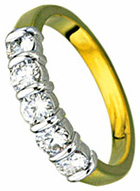...Best of Sicily presents... Best of Sicily Magazine. ... Dedicated to Sicilian art, culture, history, people, places and all things Sicilian. |
by Roberta Gangi | ||
Magazine Index Best of Sicily Arts & Culture Fashion Food & Wine History & Society About Us Travel Faqs Contact Map of Sicily |
But today the maestri whose crafts spawned these names themselves are very rare in Sicily. An exception of sorts is Palermo's tiny gold district. We should, however, make it clear at the outset that this is not a vast market trading in bullion or coins. Nor is there an assay office even remotely resembling London's with its seven-century history. The most recent mint, which functioned until the unification of Italy in 1861, is located in Piazza Marina and now houses government offices. Indeed, Italy has no public assay office. Italian gold, most of which is 18 karat, is not marked for purity by any established authority, so "under-carating" is at least theoretically possible. Italy's jewelry center is Vicenza, but that doesn't mean you won't find any good offerings in Palermo. What survives of the historic gold and jewellery district is located in a few streets off Piazza San Domenico and Via Roma near the Vucceria street market. In this square, next to the imposing San Domenico Basilica and across from a department store, is the beginning of Via Giovanni Meli, which actually traces the length of the church. This is where you'll find the shops selling all manner of trinkets and watches, and while Sicily boasts plenty of jewellery stores, this tiny area, extending to Vicolo Sant'Eligio and other narrow streets, has the greatest concentration of them. This is where the stores are, and while much of what they sell is – frankly – trendy junk of little enduring value, they offer rings, necklaces and other Italian-made items of high quality. Not much of this is actually made in Sicily, however. For that, we suggest a visit to Dispensa a few blocks away at Via Vittorio Emanuele 144. Here everything you see is made on the premises. Indeed, Dispensa, a family firm, is one of the last true jewellers in Sicily, "true" meaning that what you purchase is made by the craftsmen who sell it to you. The folks at Dispensa can sell you a ring or earrings with stones of your choice and, time permitting, create something based on your specifications. They can, for example, design something in yellow gold, as opposed to the white gold that seems so ubiquitous nowadays. Along Via Vittorio Emanuele, you'll also find other shops, including those of the Indians selling imported items – things like silver rings – at good prices. For "high end" brands there's Fiorentino on Via Roma and Via Libertà. The Italians are unparalleled as goldsmiths. As we've said, eighteen karat is the standard; don't expect less purity. When it comes to precious gem stones, they are less exacting than the British, Americans, Belgians and Dutch. That might be a factor with a particularly large stone, perhaps something of a quarter-carat or more, where quality and cut are more important. About the Author: Roberta Gangi has written numerous articles and one book dealing with Italian cultural and culinary history, and a number of food and wine articles for Best of Sicily Magazine. This is one of her rare forays into other, equally enticing, subjects. | |
Top of Page |
 Unlike some parts of Italy, Sicily boasts few districts dedicated to
the old guilds and their dying crafts. The identities of a few live on in
the names of streets in Messina, Siracusa, Catania and Palermo. In Palermo's
Piazza Marina area you'll find Via Chiavettieri (key makers' street), Via
dei Tintori (dyers' street), Via Cartari (paper maker's street) and Via
Scopari (broom makers' street), among many others.
Unlike some parts of Italy, Sicily boasts few districts dedicated to
the old guilds and their dying crafts. The identities of a few live on in
the names of streets in Messina, Siracusa, Catania and Palermo. In Palermo's
Piazza Marina area you'll find Via Chiavettieri (key makers' street), Via
dei Tintori (dyers' street), Via Cartari (paper maker's street) and Via
Scopari (broom makers' street), among many others.